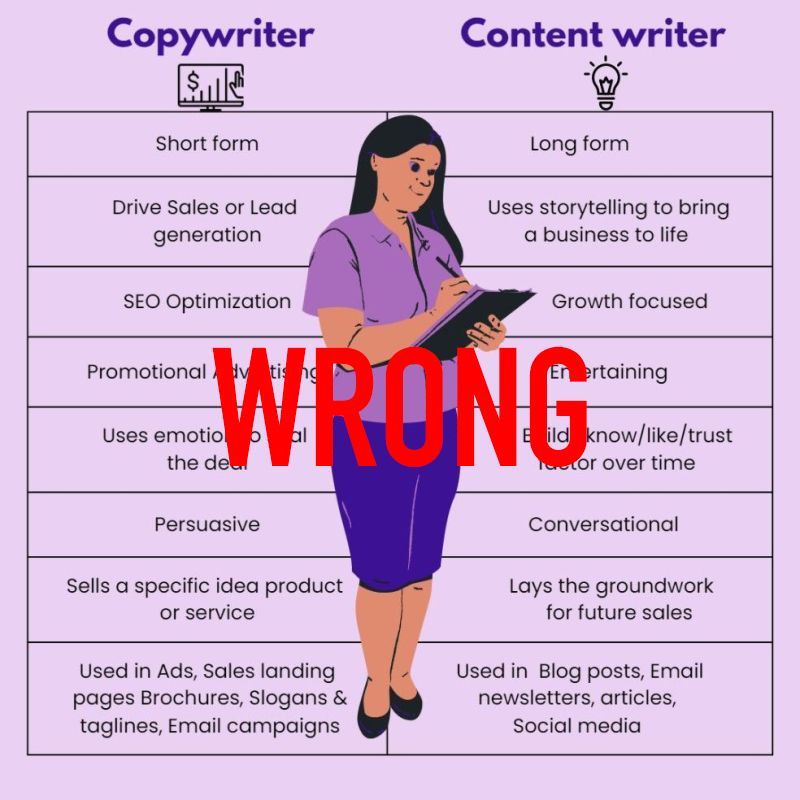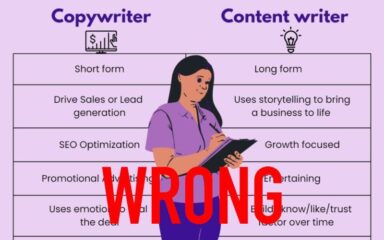
Recognize this?
I’ve seen the non-annotated version floating around, sometimes with commentary (h/t Flint Cohen, most recently), and I’ve certainly heard the sentiment expressed. And most significantly of all, I’ve heard the question, “What’s the difference between a copywriter and a content writer?”
And even worse, most frequently from baby copywriters, “Should I become a copywriter or a content writer? I hate having to choose. I like doing both.”
Dear Baby Copywriters, individuals and/or brands that might be in need of copywriting and/or content work, and anyone else who’s wandered into the idea that the two are vastly different: Do both. If you want to do both, do both.

The role of copywriter is generally pretty misunderstood. (The number of times I’ve told someone I’m an advertising copywriter and they immediately assumed I spend my days copyrighting advertising…) And that graphic up there is a great demonstration of that. The biggest thing it, and others like it, misses is that, well, content writing is a form of copywriting. It’s a subtype under the overall “copywriting” umbrella. It uses a lot of the same skills and ultimately supports the same goal, and the creator(s) of the graphic(s) has(ve) a lot of misconceptions about the nature of both copywriting as a whole and content writing specifically.
In the interest of clearing things up once and for all, here’s
Your Official, Definitive Guide
to the most popular misconceptions about copywriting and content writing.
Short form vs. Long form
This one is actually kind of subjective, because it depends on your definition of “short” and “long.” (How long is a string?) A blog post is certainly longer than a print ad, but is an infographic longer than a brochure? Is a 30-second explainer video longer than Chevy’s four-minute-long holiday ad? (By definition, no.) The biggest problem here is a limited perception of what content specifically and copywriting as a whole produce. As a matter of fact…
Used in ads and landing pages and such vs. Used in blog posts and newsletters and such
The graphic here does include an accurate list of non-content uses for copywriting — accurate, but far from comprehensive. Outdoor? Radio? Web? (I guess “break room poster” is going to be a dying medium, isn’t it.) And the “content” side leaves out a lot. As I mentioned above, explainer videos. Infographics. Podcasts. The standard article format is just the tip of the content iceberg — a digital/online format offers tons of brand-focused ways to inform and entertain, and if you limit your concept of “content” to blog posts and social media, you’re missing out. And you’re missing the mark in your understanding of the industry.
SEO optimization vs. Growth focus
This one is a pretty big giveaway that the person you’re talking to is conflating copywriting in general with direct response copywriting specifically. Officially: Copywriting does extend beyond single-sentence-paragraph emails and landing pages to include a wide variety of IRL, non-clickable formats that might include some Googleable keywords in the copy but aren’t going to nudge you to the top of the SERP, which is fine, because that’s not their purpose. (Also, I have no idea what “growth focus” is supposed to mean.) (Also, “SEO optimization” is redundant. That’s what the O stands for.)
Drive sales or lead generation vs. Inform or entertain

I mean, yeah, copywriting drives sales and generates leads. Sometimes. Sometimes, it’s promoting a product. Sometimes it’s reinforcing the overall brand. Sometimes it’s trying to establish an image of expertise, or empathy, or community-mindedness. Often, it’s entertaining. Sometimes it’s even informative. It promotes brand awareness. And it uses storytelling — hell, The Weepies, that most treasured of annual industry institutions, probably wouldn’t exist if it weren’t for storytelling in advertising. It’s one of the best ways to help your audience connect with your brand on an emotional level. Sometimes, it pushes the sale, and sometimes, it lays the groundwork for future sales. It contains multitudes. Content does generally focus on informing and entertaining specifically, but it’s not the only kind of copywriting that does that, and the rest of the copywriting field isn’t exclusively focused on making the sale.
Do you think those compelling, hard-selling Budweiser frogs drove enough conversions to cover their $1.15 million Super Bowl spot back in 1995? Or is it possible that copywriting has application at all points of the sales funnel, and a list of benefits with a CTA button at the bottom isn’t the be-all and end-all of it?
Short-term goals vs. Long-term strategy
All copywriting — the traditional kind, the direct-response kind, the content kind — is long-term, and if you’re not thinking long-term, you’re doing it wrong. Advertising executions of all kinds support a greater strategy. And all of it supports the brand, which is pretty much the longest-term aspect of the entire industry. Content isn’t a strategy — it’s part of a strategy, and if it isn’t working in concert with the rest of the brand’s marketing and advertising efforts, it isn’t going to be effective. A given ad campaign or execution might be tracked via KPIs, but so might a given blog post or series. Each element has short-term goals, and each of those goals contributes to a long-term strategy.
We get the job done.
The problem with these comparisons isn’t so much a misunderstanding of what content is (although it could be argued there’s a somewhat limited perception there) as a misunderstanding of what copywriting is. What is content? All the things that that graphic up there says, and also more. What is copywriting?
*gestures vaguely at entire career*
The important thing is that we close this artificial and arbitrary gulf between copywriters and content writers. Let’s stop pushing misconceptions about the industry that don’t serve us, our colleagues, or our clients. The reason advertising works, when it works, is because all the elements — the art, the copy, the medium, the strategy, all of it — work together, doing their jobs. Supporting the brand. Living the dream. Bringing home the bacon.

So spread your wings, writers. Be free. Be clever and strategic and persuasive and free. Tell some stories, drive some sales, grow some… whatever, and have fun doing it. And if anyone tells you you have to choose between copywriting and content, tell ‘em Caperton says they’re full of it and you get to do what you want.
It’ll mean nothing to them, because they have no reason to know who I am or care what I have to say. But I’m sure it’ll feel satisfying to say, if nothing else. Tell me what their face looks like when you do.

